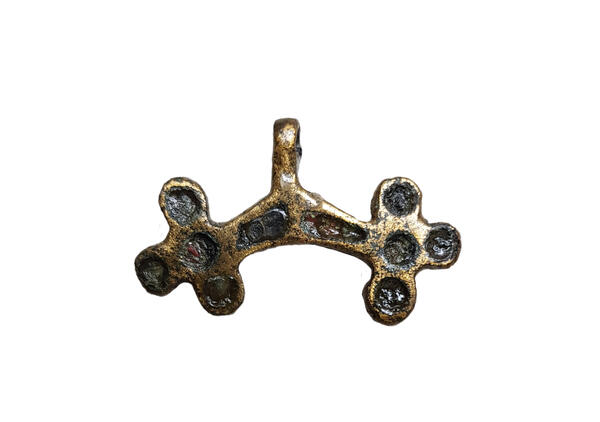The Kursk Regional Museum of Archaeology holds a lunula pendant of the 4th century. The bronze lunula pendant was found in 1986 during the excavations of the early Slavic settlement Gochevo-1 (Belovo district, Kursk region) by the archaeologists Nikolai Alekseevich Tikhomirov and Rostislav Vsevolodovich Terpilovsky.
The jewelry on display is classified as a woman’s piece of Eastern European champlevé enamel. As a rule, such items were cast from copper alloy. They were additionally decorated with enamel, which filled the recesses made beforehand during casting. The most common enamel is red, less common blue, green, white, orange and yellow. Usually, the cell contained enamel of one color, but there were exceptions when enamels of two or three colors were used.
The museum exhibit has a fully preserved loop for hanging. The casing of the amulet has an arc-like shape. There are three rounded cones on each side. Both on the casing and on the ends there are hollows in which red enamel was poured. These decorative elements have partially survived to the present day. Russian historian Andrey Mihailovich Oblomsky attributes the article on display to the second stage of the Seymynsko-Donetsk variant of the Kiev archaeological culture and dates the lunula to the 4th century. Such lunula pendants are typical for the whole area where Early Slavic antiquities were common in the Late Roman period — along the Oka and Seim rivers, as well as in the Middle part of the Dniper (including Lower Desna region).
There are two main versions of the use of the lunula as a jewlery piece: the pendant could be part of a necklace or headdress, or it could be used as a decoration on clothing. However, due to the widespread presence of such things, as well as because of the absence of inhumations (burials without burning the body of the deceased) in the Kiev archaeological culture it is impossible to establish the exact function and significance of the jewelry in the woman’s costume at the moment.
Lunula pendants, as a type of jewelry, are often found in the course of excavations. The scientific interest to them is not weakening at the present stage of the study of antiquities of the barbarian East European excised enamels. This research is particularly topical because of the contradiction between the bright and peculiar artistic style of prestigious items, where the manufacturing technique was quite complicated, and the general “primitivism” of everyday items of the archaeological cultures of Eastern Europe.
The jewelry on display is classified as a woman’s piece of Eastern European champlevé enamel. As a rule, such items were cast from copper alloy. They were additionally decorated with enamel, which filled the recesses made beforehand during casting. The most common enamel is red, less common blue, green, white, orange and yellow. Usually, the cell contained enamel of one color, but there were exceptions when enamels of two or three colors were used.
The museum exhibit has a fully preserved loop for hanging. The casing of the amulet has an arc-like shape. There are three rounded cones on each side. Both on the casing and on the ends there are hollows in which red enamel was poured. These decorative elements have partially survived to the present day. Russian historian Andrey Mihailovich Oblomsky attributes the article on display to the second stage of the Seymynsko-Donetsk variant of the Kiev archaeological culture and dates the lunula to the 4th century. Such lunula pendants are typical for the whole area where Early Slavic antiquities were common in the Late Roman period — along the Oka and Seim rivers, as well as in the Middle part of the Dniper (including Lower Desna region).
There are two main versions of the use of the lunula as a jewlery piece: the pendant could be part of a necklace or headdress, or it could be used as a decoration on clothing. However, due to the widespread presence of such things, as well as because of the absence of inhumations (burials without burning the body of the deceased) in the Kiev archaeological culture it is impossible to establish the exact function and significance of the jewelry in the woman’s costume at the moment.
Lunula pendants, as a type of jewelry, are often found in the course of excavations. The scientific interest to them is not weakening at the present stage of the study of antiquities of the barbarian East European excised enamels. This research is particularly topical because of the contradiction between the bright and peculiar artistic style of prestigious items, where the manufacturing technique was quite complicated, and the general “primitivism” of everyday items of the archaeological cultures of Eastern Europe.





